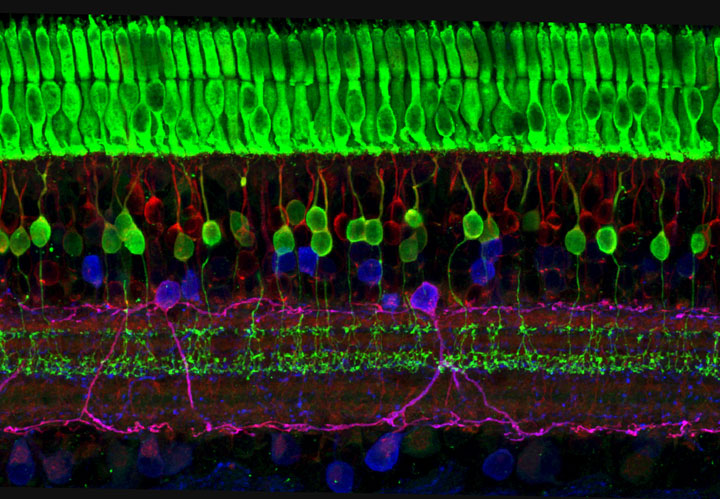Nerve Cells of Eye's Retina

Image Credit: Wei Li, National Eye Institute, National Institutes of Health
The retina of your eye consists of many interconnected layers of nerve cells, some of which are sensitive to light. Most people have heard of the two types of photoreceptors used to form images: the rod and cone cells. Recently, a third class of photoreceptors has been discovered in the retina's ganglion nerve layer. These intrinsically photosensitive retinal ganglion cells sense the general brightness of ambient light. They are linked directly to several areas of the brain where they control processes such as regulating pupil size and synchronizing the 24-hour circadian rhythm cycle. In this image the cone cells form the top (green) layer and the ganglion cells are at the bottom.
Download high-res image file | Download caption as .zip file
As células nervosas da retina do olho
A retina do seu olho consite em muitas camadas interligadas de células nervosas, algumas das quais são sensíveis à luz. A maioria das pessoas já ouviu falar dos dois tipos de fotorecetores utilizados para formar imagens: bastonetes e cones. Recentemente, uma terceira classe de fotorecetores foi descoberta na camada nervosa do gânglio da retina. Estas células do gânglio são intrinsecamente fotosensíveis e detetam o brilho geral da luz ambiente. Estão diretamente ligadas a várias zonas do cérebro onde controlam processos como a regulação do tamanho da pupila e a sincronização do ritmo ao ciclo circadiano de 24h. Nesta imagem as células-cone formam a camada de topo (verde) e as células-gânglio a camada de baixo.
Download high-res image file | Download caption as .zip file
Nervenzellen der menschlichen Netzhaut
Die Netzhaut des menschlichen Auges besteht aus vielen Schichten von Nervenzellen. Einige davon sind lichtempfindlich. Die meisten von uns haben schon von zwei Arten von Fotorezeptoren gehört, die gebraucht werden, damit ein Bild entstehen kann: Stäbchen- und Zapfenzellen. Vor kurzem wurde jedoch eine dritte Art von Fotorezeptoren entdeckt, die sich im Nervenknoten (Ganglion) der Netzhaut befindet. Diese Knoten nehmen die Helligkeit des äusseren Lichts wahr. Sie führen direkt zu verschiedenen Gehirnteilen, wo sie unterschiedliche Abläufe kontrollieren. Dazu gehören die Regulation der Pupillengrösse, sowie auch der 24-stündige Tag-Nacht-Rhythmus. Im gezeigten Bild sieht man oben die Zapfenzellen (grüne Schicht) und unten die Ganglionzellen.
Download high-res image file | Download caption as .zip file



